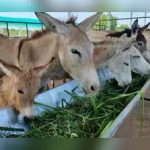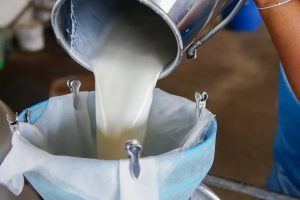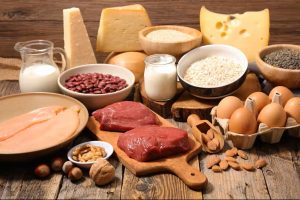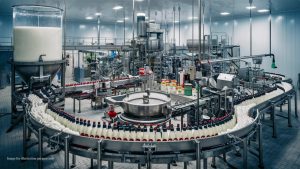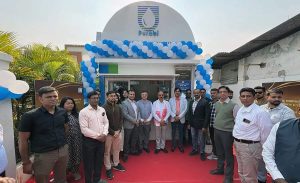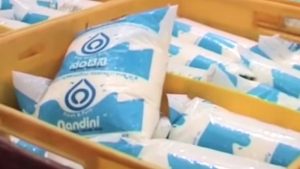
- Dairy and livestock farmers are switching to hydroponically grown fodder as an alternative to green fodder, for their animals. In the long run, the hydroponic fodder is cheaper, with control over nutrition levels.
- There is a shortage of fodder in India, particularly over the past two years. Meanwhile, the dairy industry has been growing significantly.
- Experts say hydroponic fodder is not a new concept in India, but its demand has risen in the last few years.
On a sweltering April afternoon, Mahesh S., a 28-year-old dairy farmer from Kempanapalya village in Karnataka, lifts a damp jute bag covering a green plastic tub lying in a corner in a cow shed. He checks the maize seeds he has left to sprout in it. When ready, he will place the sprouted seeds in a unit which consists of trays lined in three-tiered shelves. The shelves, covered in green shade net with a small solar panel on top, have automatic water sprinklers connected to a timer. This set up, known as a hydroponic fodder unit, is used to grow maize fodder without soil and only with moisture and nutrients.
Over a year ago, he had trouble finding the nutrient-rich green fodder for his cows. So, instead, he fed them dried maize and paddy straw. The cows produced less milk and he links it to the feed. He supplied lesser than usual milk to the Karnataka Milk Federation and then decided to change things. “I watched many videos of hydroponic fodder on YouTube,” he said. This motivated him to set up a hydroponic fodder unit in his home with a bank loan and assistance from Selco Foundation, a Bengaluru-based solar energy nonprofit and AutoStudio, a startup selling the fodder units.
“Hydroponic fodder is digested better by the animal and the milk production has increased by one and a half litres per cow, daily,” said Mahesh, who now earns an additional Rs. 30,000-40,000 each month. He is among a growing number of farmers across the country who are switching to hydroponic fodder production. In this method, fodder is farmed vertically without any soil, using only nutrients and water. This method of production uses less water and area, as compared to cultivating fodder in soil. It also reduces growth time, producing fresh fodder in eight days, compared to 45 days for conventional fodder and with higher crude protein content.

Fodder shortage
There is a 35.6% deficit of green fodder in India, according to a review published in 2022. The causes of this shortage are changes in land use patterns, urbanisation, diminishing productivity of pastureland, a shift towards cash crops, diverting crop residues to other industries, quality fodder seeds not being available and the growing demand for fodder, according to an answer provided by the Ministry of Fisheries, Animal Husbandry and Dairying in the Lok Sabha in 2022.
Climate change is also a matter of concern as it impacts livestock feed production, according to a 2021 study. “Global warming and its associated changes in mean climate variables and climate variability affect feed and water resources as well as animal health and production, notes the study, adding that climate change also has implications for the processing, storage, transport, retailing and consumption of livestock products.

“There is perpetually a fodder crisis,” said Anshul Ojha, founder and principal anchor at Desert Resource Centre, an organisation working with agropastoralists in rural Rajasthan to bring hydroponic fodder to the community through testing and innovation, since 2019. Ojha pointed out that the degradation of village commons and shrinking grazing lands have also exacerbated this crisis. When fodder is scarce, farmers reduce the number of their animals or completely stop raising them, he told Mongabay-India.
The dairy industry has been growing for the last decade and employs 80 million farmers directly in the country, making India the biggest milk producer in the world. The high consumption and rising demand for milk coupled with fodder scarcity leads to adulteration, where farmers try to create synthetic milk to maximise the value of their cattle, said Ojha.
“Fodder is also getting diverted to the biomass industry for ethanol production,” said Vasanth Madhav Kamath, co-founder of Hydrogreens, a startup selling hydroponic fodder units since 2019. India’s focus on increasing the production of ethanol derived from feedstock for energy security also puts a burden on farms. This creates a larger competition for biomass, which pushes out small and marginal farmers, Kamath said.
Hydroponics, an old technique with new demand
Hydroponic fodder has been around for decades now. In the 1980s, the Indian government imported some machines for cultivating hydroponic fodder. However, these were highly expensive and required an uninterrupted power supply to maintain a specific temperature. “The technology didn’t take off,” said K. Giridhar, principal scientist at the National Institute of Animal Physiology and Nutrition (NIANP), Bengaluru.
However, it has gained momentum in recent years with private companies manufacturing and selling hydroponic units, nonprofits like Selco Foundation funding hydroponic fodder startups such as Hydrogreens and Auto Studio and connecting them to community-based organisations such as Desert Resource Centre and Urmul Seemant Samiti in Rajasthan. Government institutions such the Indian Council of Agricultural Research (ICAR) Goa, NIANP, ICAR-Indian Grassland and Fodder Research Institute, and Krishi Vigyan Kendras (KVKs) have also been researching this technique.
According to a 2021 market analysis by the Council on Energy, Environment and Water (CEEW), an environmental think tank, the market for small-scale hydroponic fodder units is Rs. 23,905 crore. The analysis also states that the majority of this market lies in Uttar Pradesh, Rajasthan, Gujarat, Maharashtra, Karnataka, Andhra Pradesh, Tamil Nadu, Madhya Pradesh, Telangana and Bihar.

Ashwin Sawant, who runs a hydroponic fodder research and training centre has observed a rise in the number of inquiries for hydroponic fodder units since last year. Sawant runs Scientific Hydroponics, a Pune-based organisation that has been training farmers since 2015. Sawant, who has been doing research in his farm-turned-lab on this method since 2011, also installs customised hydroponic fodder units across India based on farmers’ needs, type of livestock and local climate.
There are different types of hydroponic fodder units available in the market. While newer and cheaper units require just a shade net and a solar panel for electricity, older and more expensive units require a controlled, air-conditioned environment in a shipping container, powered by the grid.
The science of hydroponics
Growing hydroponic fodder is similar to making sprouts from legumes at home, explained Giridhar of NIANP, while talking to Mongabay-India. First, you soak seeds or grains. Then, you wrap them in a damp jute bag and leave them to sprout. Once ready, you place the sprouts on trays. You can now spray water on the seeds manually or with a sprinkler at regular intervals. Soon, the sprouts begin to grow into what looks like grass, and within a week, the fodder is ready to be harvested. He recommends growing fodder from maize, wheat, cowpea, horse gram, barley and rice bean.
The amount of hydroponic fodder a cow or buffalo needs everyday depends on its body weight, milking requirement and the amount of fat and protein the farmer wants in the milk, explains Sawant. Depending on whether a cow is young, pregnant or old, farmers feed them anywhere between 15-35 kg of hydroponic maize fodder per day. Trays for growing hydroponic fodder come in different sizes. If you are using a 1.3 x 1.7 ft tray and you need one tray of fodder daily, you need to multiply the number of cattle by eight to arrive at a final number of trays because hydroponic maize fodder has an 8-day growth cycle, explained Kamath.
“It looks so simple – you put in a few trays and sprinklers. Farmers who do it themselves often fail,” said Kamath. He explains that one needs the right combination of seed density, seed quality and amount of water to succeed. “Farmers often fill the trays with too many seeds, which increases humidity and stops germination, or they procure the wrong seeds,” he said.

In 2021, NIANP developed a protocol for producing hydroponic fodder in collaboration with Hydrogreens. “It covers the amount of water and frequency of spraying and the quantity of grain to be used based on tray size,” said Giridhar.
Boosting milk production
Over the years, there has been growing scientific consensus on the benefits of hydroponic fodder. The fodder is found to be rich in a variety of nutrients such as protein, vitamins, minerals, thiamine, riboflavin, free folic acid, biotin, antioxidants and beta-carotene, which improves the reproductive health of dairy cows and milk yields, according to a review published last year. Studies done in Jordan and Saudi Arabia have shown improved performance and growth in lambs and goats, respectively.
Scientists have also studied whether hydroponic fodder can lower methane emissions from livestock and the results have varied. A study published in 2023 by Tamil Nadu Veterinary and Animal Sciences University, Chennai, found that cows who ate hydroponic pearl millet fodder had the lowest methane production. However, a 2022 study by ICAR on lambs fed hydroponic maize fodder as a substitute for green fodder and compounded feed mixture showed that it was not beneficial in improving rumen fermentation and methane reduction.
Challenges with hydroponic fodder
Among the most common problems in growing hydroponic fodder is the fungus or mould on the seeds or fodder. This happens due to excessive moisture and during the monsoon. The lack of quality seeds is also a major obstacle that can lead to underutilisation of these units.
Purkharam Meghwal, a farmer in Rajasthan, bought a hydroponic unit subsidised by Urmul Seemant last year. During the winter, he was able to grow wheatgrass fodder for his cows, but since March, his machine has been lying unused. “I have not been able to find any maize seeds yet,” he said.

Another issue is technical failures and lack of maintenance services that lead farmers to abandon the machines. “My only feedback to the manufacturers is to improve the timers,” said Meghwal, who had the broken timer on his unit replaced by Hydrogreens.
In India, where many livestock farmers have a small number of animals and struggle to keep themselves afloat, the high price of installing a hydroponic fodder unit can also be a deterrent. Sawant, who has set up 150 units to date, said that one can set up a small hydroponic fodder unit for Rs. 50,000. While Mahesh spent Rs. 52,000 on his unit, including the solar panel and paid for it with a bank loan, Meghwal got his unit for Rs. 22,000 through a subsidy from Urmul Seemant.
To address the problems of installation cost, seed supply and technical maintenance, Hydrogreens has been working on the concept of providing “fodder as a service” to farmers through fodder stations, Kamath told Mongabay-India. At Urmul Seemant’s campus in Bajju village, the startup has collaboratively set up a fodder station through which farmers who supply milk to Urmul’s dairy cooperative can buy fodder at a low price.
For Mahesh, having his hydroponic unit has meant spending less time and labour collecting green fodder. He has bought more cows with his increased income. “I plan to add one more hydroponic fodder unit in the coming times,” he said.


